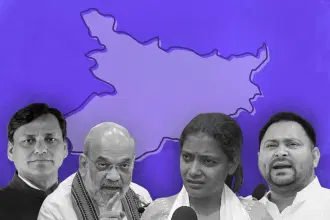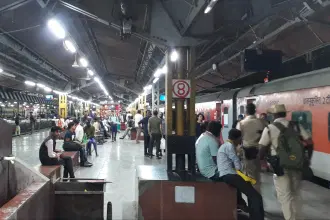Politics
The Exam Wars: How Student Protests Are Reshaping India's Political Landscape
Abhishek Kumar
Sep 22, 2025, 12:50 PM | Updated 12:50 PM IST
Save & read from anywhere!
Bookmark stories for easy access on any device or the Swarajya app.


The scene has become disturbingly familiar across India's examination centres. Before entering, aspirants frantically search through Telegram groups for leaked question papers and answers. As they emerge hours later, a shadow looms overhead, the ever-present threat that their examination will be cancelled due to irregularities.
More often than not, these fears materialise. In coaching hubs from Bhopal to Delhi, thousands of young graduates, mid-career job seekers, and first-generation degree holders unite in a familiar chorus: cancel the exam, restart the process, ensure fairness. When mainstream media ignores their plight, they turn to YouTubers who broadcast their grievances in detail, amplifying their voices across digital platforms.
This new mode of mobilisation is fundamentally reshaping India's street politics. While Indian students have long traded lecture halls for protest squares, today's movement is notably different. Political factions remain largely absent from the frontlines. The exception was the 2024 Bihar Public Service Commission (BPSC) protests, where political strategist Prashant Kishor staged a fast-unto-death, but even there, students led the charge.
In a nation where competitive examinations remain the primary gateway to social mobility, these protests have transformed the testing system into a political powder keg, ready to be exploited by those seeking regime change.
India’s Year of Examination Fury
The year 2024 will be remembered as the year examination protests reached a fever pitch across India. The pattern was consistent. Allegations of leaks, technical failures, and procedural irregularities sparked massive demonstrations that paralysed cities and challenged state authority.
In December 2024, over 3,000 BPSC aspirants blocked major roads in Patna, their placards declaring Leak Nahin Sahenge (We Will Not Tolerate Leaks). When police responded with tear gas, the protesters only strengthened their resolve. Just a month earlier, Jaipur had witnessed similar scenes as Rajasthan Public Service Commission (RPSC) candidates hurled stones at riot shields.
The National Eligibility cum Entrance Test (NEET-UG) scandal in May shook the foundation of India's medical education system. More than 2.4 million aspirants took to the streets in Delhi, Hyderabad, Varanasi, Kalaburagi, Patna, and Chennai, accusing the National Testing Agency of systemic fraud. The controversy centred on paper leaks, result irregularities, and the awarding of grace marks that skewed merit rankings.
June brought the abrupt cancellation of the UGC-NET examination after question papers surfaced on the dark web. The Education Ministry ordered a CBI investigation, but the damage was done. Lakhs of candidates found their preparation efforts wasted and their futures uncertain.
By November and December, Prayagraj became the epicentre of sustained unrest. Students protested against normalisation procedures and other irregularities in the Uttar Pradesh Public Service Commission (UPPSC) preliminary examinations. Thousands staged week-long sit-ins outside the Commission's headquarters, bringing the state capital to a virtual standstill.
Indore witnessed nearly 2,000 Madhya Pradesh Public Service Commission (MPPSC) aspirants staging a four-day protest after negotiations with officials failed. The state's chequered record in conducting fair examinations has been a persistent problem for over a decade.
The crisis extended to national-level examinations when Eduquity Career Technologies, the vendor chosen by the Staff Selection Commission (SSC), created chaos through systematic mismanagement. Early patronage given to Eduquity in Madhya Pradesh's Patwari examination later contaminated national SSC tests. The vendor's practice of last-minute subcontracting left lakhs of candidates facing an uncertain fate.
Finally, Delhi erupted in protests as teachers and job aspirants joined forces against examination irregularities. The Commission managed to buy time by conducting re-examinations for over 59,000 students, but legal challenges in courts seemed inevitable.
The Anatomy of Systemic Failure
Across these episodes, common patterns emerged that revealed deep structural problems in India's examination ecosystem. Last-minute changes to exam dates became routine, forcing students to choose between competing tests. Opaque score normalisation processes left candidates unable to understand their rankings. Technical glitches in digital administration systems caused widespread disruption.
Perhaps most damaging was the complete erosion of trust in grievance redressal mechanisms. Delayed result uploads and procedural opacity created a widespread sense that fairness had evaporated from the system entirely.
The Aspiration Explosion
While examination irregularities have long plagued India's testing system, the intensity and frequency of current protests demand explanation. The answer lies not in the scale of unfairness, but in the expanding base of aspirants who can see the pinnacle of success but feel unjustly denied access to it.
Indian youth aspirations have undergone a dramatic transformation over the past decade. As basic needs like food, water, and shelter reach unprecedented levels of satisfaction, families now expect their children to compete directly with society's upper echelons. The proliferation of web series and digital content has made power, prestige, and wealth more visible and desirable than ever before.
This shift profoundly affects first-generation graduates who view the private sector as a money-making opportunity while perceiving government positions as bastions of respect and power. The challenge is geographic. Most aspirants come from tier-II, III, and IV cities where private sector salaries peak at ₹15,000 for fresh graduates. Meanwhile, government jobs still promise respect, security, air-conditioned offices, official vehicles, pensions, advantageous marriage prospects, and whispers of additional income streams.
The economic stakes are enormous. According to the 2023-24 Household Consumption Expenditure Survey, rural households spend approximately ₹4,122 per person per month, while urban families spend ₹6,996. More troubling, 47 per cent of rural budgets and 40 per cent of urban ones are consumed by food expenses. For rural families, examination preparation represents a particularly heavy financial burden.
When candidates take to the streets, they are not merely protesting leaks or postponements. They are fighting for rent money, food expenses, borrowed funds, and opportunity costs. The discontent now transcends traditional boundaries of caste, religion, gender, and political affiliation, with both general and reserved category candidates sharing a deep sense of betrayal.
International Parallels: Bangladesh and Nepal
This phenomenon extends beyond India's borders. In mid-2024, Bangladesh witnessed similar unity when nationwide student-led protests erupted against the job quota system. Initial demands to reform a system reserving large portions of civil service positions for Liberation War fighters' descendants quickly expanded as narratives of corruption, nepotism, and authoritarian governance spread.
What began as manageable demonstrations rapidly spiralled out of control when political opportunists seized the moment. Violent clashes with law enforcement resulted in over 100 deaths and ultimately contributed to a coup led by Nobel Prize Laureate Mohammad Yunus that ousted Sheikh Hasina.
Nepal presents another cautionary tale. With unemployment at 20.8 per cent in December 2024, Gen Z youth bore the brunt of corruption, political instability, and absent economic opportunities in a remittance-dependent economy. The trigger was envy towards bureaucrats' and politicians' children who enjoyed privileged access to public resources while ordinary youth struggled.
A poorly timed social media ban served as the immediate catalyst, causing Gen Z anger to explode. Protesters first struck the Nepali Parliament, then expanded their attacks to include the Government Secretariat, Supreme Court, Prime Minister's residence, President's residence, and homes of senior political leaders. At least 22 protesters died, but such casualties pale compared to the broader regime change implications.
The Three Pillars of Revolutionary Potential
What transforms relatively minor grievances into regime-threatening movements? Three critical factors emerge from analysing successful protest movements.
The first ingredient is sheer numerical strength. India's aspirant army is massive. Between 25 and 35 lakh students apply for SSC examinations, over 20 lakh for NEET, 10 to 13 lakh for UPSC Civil Services, and 4 to 10 lakh for various state PCS examinations. Similar numbers apply to banking, engineering entrance, and law examinations.
Protest scales match these numbers. Demonstrations against particular examinations routinely draw thousands, as witnessed in Patna, Prayagraj, Bhopal, Indore, Jaipur, and Delhi. Recent ABVP protests against the Yogi Adityanath government in Uttar Pradesh demonstrated students prioritising self-interest over party and ideological lines.
This unity creates opportunities for narrative manipulation. While technical glitches and normalisation procedures may trigger initial protests, most aspirants do not intend to sustain week-long demonstrations until larger narratives of systemic nihilism take hold.
The Nihilism Mechanism
Media headlines may focus on recent events, but in aspirants' minds, the stakes involve dignity, fairness, and the state's fundamental promise to maintain a level playing field. Large demonstrations are motivated by profound futility. Years of investment, resources, and personal sacrifice appear wasted on a rigged or capricious system.
When repeated disappointments such as delays, cancellations, shifting cut-offs, unfair grading, and failed grievance redressal cross individual psychological barriers, nihilism replaces systemic faith. Questions multiply. Why trust the process? Why wait for slow reforms? Why not take to the streets?
Opposition political factions exploit this vulnerability by introducing mobilising slogans that channel youth discontent to their advantage. Electronic mediums spread established narratives that can vastly exceed actual ground-level traction. Leaders make anti-government claims with minimal evidentiary support, relying on fading public memory and blending old grievances with new complaints to fuel fresh unrest.
In a culture increasingly dependent on brief video clips for information, protests limited to specific geographical areas can be portrayed as nationwide civil unrest through unsubstantiated data manipulation. International celebrities quickly seek to support groups with financial resources but limited mass mobilisation potential.
These amplified narratives help gather larger crowds and facilitate easier mobilisation. When aspirants feel they have nothing to lose, especially when reinforced by messages that the system is fundamentally broken, loosely coordinated protests can become spontaneous, volatile, and unpredictable, as seen in Nepal, the United States Capitol riots, and Delhi's 26 January violence.
The formula is straightforward. Seize a prominent building and control cascades, while opposition parties and anti-incumbent organisations use social media to amplify negativity and give global relevance to potentially local discontent. Even protests beginning in Prayagraj or Jaipur can echo in Lucknow, Patna, Bhopal, or Bhubaneswar. When thousands are already sensitised, aspirant protests can rapidly mutate into larger anti-state demonstrations, creating domino effects once narratives go viral. Nepal, Sri Lanka, and Bangladesh provide strong evidence of this pattern.
Beyond Examinations: Governance at Stake
Student and aspirant unrest is never solely about examinations. It becomes a proxy for broader governance failures. With an average age of 28.4 years, India stands at a crucial demographic juncture. This is when most aspirants' families have exhausted their resources, forcing candidates to work while preparing for examinations during pre- or post-job hours. The scale of anxiety regarding fairness is difficult to comprehend.
Each leak or botched examination undermines faith in state fairness, dangerous in a country where competitive tests are treated as sacred gateways to advancement. Another factor driving aspirant discontent is the declining perception of civic infrastructure: collapsing bridges, flooded roads, unaffordable housing, and the futility of resource accumulation. Elite dissatisfaction on these fronts tends to attract significant funding for protests marketed as civil society movements.
Toward Sustainable Solutions
The governing coalition has responded swiftly to multiple crises, sometimes at the cost of political capital. Despite facing criticism from supporters on issues such as farm law rollbacks and caste census agreements, the government has prioritised long-term peace and harmony.
Tackling student protests demands innovative approaches beyond current case-by-case treatments. Announcing vendor changes for SSC or single-shift examinations for UPPSC may solve immediate crises but postpone future problems.
Government must distinguish between long-term structural issues, such as SSC vendor problems, and short-term discontent while maintaining closer monitoring of student politics. The time has come to move beyond treating these as mere law-and-order problems and recognise them as issues requiring immediate resolution.
Authorities must understand that obstacles to student welfare are not glitches in the system, they are fundamental components of the system itself. These problems originate at the top, flow through institutional channels, and are first identified by vigilant students. While many protesters harbour political aspirations, separating legitimate grievances from opportunistic manipulation remains the government's crucial responsibility.
The examination crisis represents more than administrative failure. It threatens the social contract between state and citizen in democratic India. Without comprehensive reform addressing structural weaknesses in testing systems, grievance mechanisms, and transparency protocols, the current unrest may prove to be merely a preview of more serious challenges ahead.
The aspirations of India's youth cannot be contained indefinitely by inadequate systems, and the state's legitimacy increasingly depends on its ability to deliver fair opportunities for advancement through merit-based selection processes.
Abhishek is Staff Writer at Swarajya.





